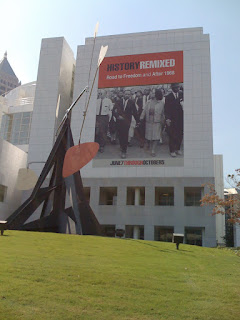"History Remix" revisited:
There is a display case in one of the galleries that contains a photograph and open magazine in which the photograph was printed. It gave me pause.
Mrs. Blackman and Baby in Her Cabin, Trickman Fork, Alabama 1965 by photographer Bruce Davidson. He joined forces with two other journalists and created a nine page feature titled “The Meaning of the Selma March” for the Saturday Evening Post (May 22, 1965).
The photo is of the “colored” mother of nine standing in a doorway of her home holding her baby. The photographer is inside the room and photographs her looking back inside toward him. He is able to capture a room with a fireplace with a cork board above holding two identical images of santa clause. The walls are papered with newsprint and magazine pages. There are at least two beds in this untidy room. It is a poignant picture of poverty made more so by the caption. Davidson asked Mrs. Blackman if she new why the marchers had come. Her response was simply, “No sir, I don’t know why they march”
And yet, the marchers came and marched. Their coming was a certain disruption to the communities through which they passed. Those who remained after the marchers left surely bore the brunt of the hostilities of those who were happy with life as it had been. Though change was not immediately apparent, life would never be the same because of those marchers and other protesters and silent pray-ers and strategic organizers and invisible supporters and unnamed martyrs.
I wonder how they thought about marching for those who didn’t know why they marched.
How are you marching for those who don’t know why you march?
How are you loving for those who don’t know why you love?
Did not Jesus die for those who did not know why He died?
Rabbi Abraham Heschel said that when he participated in the Selma march that he was aware that he was praying with his feet. I have been meditating on these images and meditating on how these folk loved with their feet as they marched.
How do you love today?
How can / do / could / should we love together today?
I’d love to hear from you.
Belin


